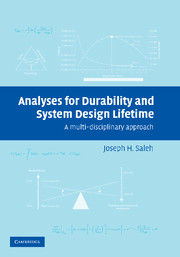Book contents
- Frontmatter
- Contents
- Preface
- 1 Introduction: On Time
- 2 To Reduce or to Extend Durability? A Qualitative Discussion of Issues at Stake
- 3 A Brief History of Economic Thought on Durability
- 4 Analysis of Marginal Cost of Durability and System Cost per Day
- 5 Flawed Metrics: System Cost per Day and Cost per Payload
- 6 Durability Choice and Optimal Design Lifetime for Complex Engineering Systems
- EPILOGUE: Perspectives in Design: The Deacon's Masterpiece and Hundred-Year Aircraft, Spacecraft, and Other Complex Engineering Systems
- APPENDIX A Beyond Cost Models, System Utility or Revenue Models: Example of a Communications Satellite
- APPENDIX B On Durability and Economic Depreciation
- Index
- References
1 - Introduction: On Time
Published online by Cambridge University Press: 25 October 2009
- Frontmatter
- Contents
- Preface
- 1 Introduction: On Time
- 2 To Reduce or to Extend Durability? A Qualitative Discussion of Issues at Stake
- 3 A Brief History of Economic Thought on Durability
- 4 Analysis of Marginal Cost of Durability and System Cost per Day
- 5 Flawed Metrics: System Cost per Day and Cost per Payload
- 6 Durability Choice and Optimal Design Lifetime for Complex Engineering Systems
- EPILOGUE: Perspectives in Design: The Deacon's Masterpiece and Hundred-Year Aircraft, Spacecraft, and Other Complex Engineering Systems
- APPENDIX A Beyond Cost Models, System Utility or Revenue Models: Example of a Communications Satellite
- APPENDIX B On Durability and Economic Depreciation
- Index
- References
Summary
Sundials and Human Time
This story begins with a sundial. One of France's famed fishing ports, at the lower tip of Brittany, is a medieval walled town called Concarneau. A walk though the old city, as in a few others in France, is a spellbinding experience for the visitor. Here, time does not seem to have taken as heavy a toll as in other places. A sundial on the outside wall of one of the old houses in Concarneau carries the inscription Tempus Fugit Velut Ombra, which means “time flies [or escapes] like a shadow.” I am very fond of this inscription for many reasons. A casual reading of this inscription suggests that it is a clever indication of the obvious: as the day goes by and the Sun traces its path across the sky, the shadow of the gnomon moves along the surface of the sundial … and time flies, along with this shadow's movement. But the word “like” or velut in the inscription, instead of “with” for example, invites the reader to a second, deeper, interpretation: the inscription may be suggesting that, like the shadow, time is elusive and (any presence in it) ephemeral. The inscription, although conveying a sense of fragility, does not decry the destructive side of time, nor does it succumb to the traditional view of time as the destroyer of all things. Tempus edax rerum, time the devourer of all things, cried the Roman poet Ovid.
- Type
- Chapter
- Information
- Analyses for Durability and System Design LifetimeA Multidisciplinary Approach, pp. 1 - 13Publisher: Cambridge University PressPrint publication year: 2007

